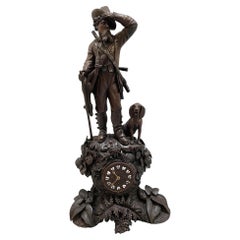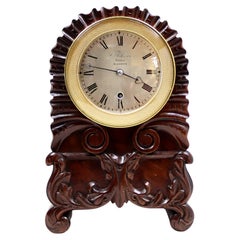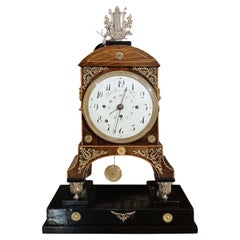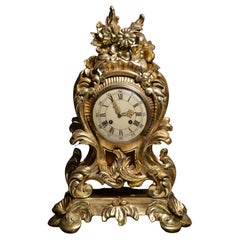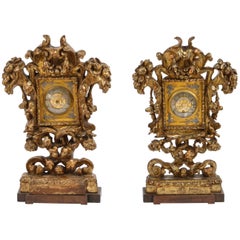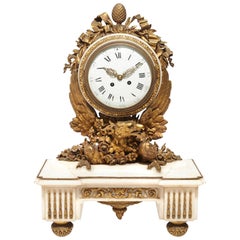Carved Table Clocks and Desk Clocks
to
8
61
8
6
30
25
8
11
6
8
3
1
4
1
3
4
4
12
7
5
3
3
2
2
2
2
1
1
1
1
55
31
27
26
18
42
25
64
19
18
9
6
Height
to
Width
to
69
61
61
8
8
6
2
2
Technique: Carved
19th Century 'Black Forest' Carved Clock with Hunter and Hound
Located in London, GB
A black forest carved hunt clock
Constructed from native Swiss Lindenwood, the clock movement denoting the hours in enamelled Roman numerals and housed w...
Category
19th Century Swiss Black Forest Antique Carved Table Clocks and Desk Clocks
Materials
Wood
Miniature Single Fusee Bracket Clock By William Johnston, Strand, London
By Johnson
Located in Amersham, GB
An extremely small single fusee bracket clock in a scalloped mahogany case. The eight day movement having a half deadbeat escapement with a T bar pendulum with hold fast, is beautifu...
Category
1830s English William IV Antique Carved Table Clocks and Desk Clocks
Materials
Brass, Ormolu
EARLY 19th CENTURY VIENNESE EMPIRE CLOCK
Located in Firenze, FI
Beautiful clock in walnut root, enriched with maple fillets and with an ebonized wooden base. The decoration of the clock features gilded bronze friezes, inspired by classical elemen...
Category
Early 19th Century Austrian Empire Antique Carved Table Clocks and Desk Clocks
Materials
Bronze
Swedish Clock by Westerstand Carved Gilt Wood Rococo Style mid 20th century
Located in Sweden, SE
Gorgeous 25 inches (!) tall hand carved and gold leaf floral motive Rococo clock made in 1 copy ca 1950 by Westerstrand or Westerstrand Urfabrik Aktiebolag, one of Töreboda's oldest ...
Category
Mid-20th Century Swedish Rococo Carved Table Clocks and Desk Clocks
Materials
Gold, Brass
Pair of 18th century Italian Clock and Barometer
Located in Los Angeles, CA
Pair of 18th century Italian carved wood fragments with clock and barometer.
Category
18th Century Irish Antique Carved Table Clocks and Desk Clocks
Materials
Giltwood
$7,500 / set
French Ormolu Marble Mantel Clock, 19th Century
Located in Cypress, CA
Spectacular and unique French Napoleon III ormolu mounted white marble mantel clock, 19th century.
The clock is surmounted by a gilt bronze pineapple finial with ribbons over a porcelain clock face with Roman Numerals enclosed into an ormolu egg...
Category
19th Century French Louis XVI Antique Carved Table Clocks and Desk Clocks
Materials
Marble, Bronze
Art Deco Period Table Clock
By Mersman
Located in Los Angeles, CA
A stylish, large, looping table clock from Swiss maker, Mersmann. The rectangular time piece reading "8 Days" and "Swiss", at the bottom center of the Roman numeral, hour designation...
Category
1920s Swiss Vintage Carved Table Clocks and Desk Clocks
Materials
Onyx
Second Empire Bronze and Marble Mantel Clock
Located in Montreal, QC
This fine French clock, in an arched verde antico marble case, is set with a bas relief panel depicting Homer. The declaiming blind poet carries his lyre, a young boy leading him. It...
Category
1860s French Empire Revival Antique Carved Table Clocks and Desk Clocks
Materials
Marble, Bronze
Impressive Antique Austrian Champlevé Enamel, Silver-Gilt and Lapis Lazuli Clock
Located in London, GB
Impressive antique Austrian champlevé enamel, silver-gilt and lapis lazuli clock set
Austrian, Late 19th century
Clock: Height 91cm, width 37cm, depth 37cm
Candelabra: Height 64cm, width 24cm, depth 24cm
Clock case: Height 97cm, width 44cm, depth 41cm
Candelabra case: 67cm, width 27cm, depth 27cm
Crafted in Austria in the late 19th century, this magnificent three-piece clock set was most likely gifted to the Imperial Russian family by the Austro-Hungarian Royal family. Its design is inspired by various cultures and styles, whilst its high quality celebrates some of the best craftsmen of the late 19th century.
Of a tiered pagoda shape, the clock is surmounted by an eagle, its wings spread wide landing atop a vibrant lapis lazuli ball. The eagle is most likely a reference to Turul, a mythological animal which is a symbol of Hungary. This bird of prey is also a popular feature within Turkish traditions.
Within a canopy, supported on four sturdy lapis lazuli pillars two prominent silver-gilt bells are hanging. These are carved with various motifs such as acanthus leaf design and connect to the clock mechanism below. The bells ring informing its users of the time.
All four sides of the piece are inset with a clock, an unusual feature on an object of this type and a testament to its highest quality. The inclusion of clocks on all sides signifies that the antique is aimed to be a centrepiece, admired from all sides. The dial is decorated using the champlevé enamelling technique, whereby ‘parcels’ are carved into the silver gilt and into which enamel is poured. The 12 numbers are coloured in black with a gold outline and are surrounded by a white circular background making them stand out and easy to read. The hour clock dial is cast in the form of a sun, while the minute hand is represented as the moon. The two motifs symbolise one’s bright and gloomy sides of existence.
The four corners around the clocks are mounted with three-dimensional female figures dressed in traditional garments from around the world. For example, one figure is dressed in typical Turkish clothing...
Category
Late 19th Century Austrian Antique Carved Table Clocks and Desk Clocks
Materials
Lapis Lazuli, Silver, Bronze, Enamel
Recently Viewed
View AllMore Ways To Browse
Barometer Thermometer Hygrometer Vintage
Chess Clock
Chimney Clocks
Clock Telechron Vintage
Depose Brass
Heinrich Moller Kienzle
Jaeger Lecoultre Skeleton Clock
Kienzle Moller
Kienzle World Clock
Kienzle World
Lecoultre Skeleton Clock
Looping Clock
New England Clock Company Models
Swinging Clock
Time Zone Clock
Verge Clock
1970s Alarm Clock
Alfred Dunhill Art Deco Clock
